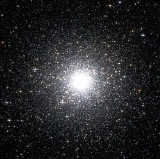
Messier 54
Encyclopedia
Messier 54 is a globular cluster
in the constellation
Sagittarius
. It was discovered by Charles Messier
in 1778 and subsequently included in his catalog of comet
-like objects.
Previously thought to belong to our Galaxy at a distance from Earth
of about 50,000 light-year
s, it was discovered in 1994 that M54 most likely belongs to the Sagittarius Dwarf Elliptical Galaxy
, (SagDEG), making it the first globular cluster formally thought to be part of our galaxy reassigned to extragalactic status, even if not recognized as such for nearly two and a quarter centuries.
Modern estimates now place M54 at a distance of some 87,000 light-years, translating into a true radius of 150 light-years across. It is one of the denser of the globulars, being of class III (I being densest and XII being the least dense). It shines with the luminosity
of roughly 850,000 times that of the Sun
and has an absolute magnitude
of -10.0.
M54 is easily found on the sky, being close to the star
ζ Sagittarii
. It is however, not resolvable into individual stars even with larger amateur telescope
s.
In July 2009, a team of astronomers reported that they had found evidence of an intermediate-mass black hole
in the core of M54.
Globular cluster
A globular cluster is a spherical collection of stars that orbits a galactic core as a satellite. Globular clusters are very tightly bound by gravity, which gives them their spherical shapes and relatively high stellar densities toward their centers. The name of this category of star cluster is...
in the constellation
Constellation
In modern astronomy, a constellation is an internationally defined area of the celestial sphere. These areas are grouped around asterisms, patterns formed by prominent stars within apparent proximity to one another on Earth's night sky....
Sagittarius
Sagittarius (constellation)
Sagittarius is a constellation of the zodiac, the one containing the galactic center. Its name is Latin for the archer, and its symbol is , a stylized arrow. Sagittarius is commonly represented as a centaur drawing a bow...
. It was discovered by Charles Messier
Charles Messier
Charles Messier was a French astronomer most notable for publishing an astronomical catalogue consisting of deep sky objects such as nebulae and star clusters that came to be known as the 110 "Messier objects"...
in 1778 and subsequently included in his catalog of comet
Comet
A comet is an icy small Solar System body that, when close enough to the Sun, displays a visible coma and sometimes also a tail. These phenomena are both due to the effects of solar radiation and the solar wind upon the nucleus of the comet...
-like objects.
Previously thought to belong to our Galaxy at a distance from Earth
Earth
Earth is the third planet from the Sun, and the densest and fifth-largest of the eight planets in the Solar System. It is also the largest of the Solar System's four terrestrial planets...
of about 50,000 light-year
Light-year
A light-year, also light year or lightyear is a unit of length, equal to just under 10 trillion kilometres...
s, it was discovered in 1994 that M54 most likely belongs to the Sagittarius Dwarf Elliptical Galaxy
Sagittarius Dwarf Elliptical Galaxy
The Sagittarius Dwarf Elliptical Galaxy is an elliptical loop-shaped satellite galaxy of the Milky Way Galaxy. It consists of four globular clusters, the main cluster being discovered in 1994...
, (SagDEG), making it the first globular cluster formally thought to be part of our galaxy reassigned to extragalactic status, even if not recognized as such for nearly two and a quarter centuries.
Modern estimates now place M54 at a distance of some 87,000 light-years, translating into a true radius of 150 light-years across. It is one of the denser of the globulars, being of class III (I being densest and XII being the least dense). It shines with the luminosity
Luminosity
Luminosity is a measurement of brightness.-In photometry and color imaging:In photometry, luminosity is sometimes incorrectly used to refer to luminance, which is the density of luminous intensity in a given direction. The SI unit for luminance is candela per square metre.The luminosity function...
of roughly 850,000 times that of the Sun
Sun
The Sun is the star at the center of the Solar System. It is almost perfectly spherical and consists of hot plasma interwoven with magnetic fields...
and has an absolute magnitude
Absolute magnitude
Absolute magnitude is the measure of a celestial object's intrinsic brightness. it is also the apparent magnitude a star would have if it were 32.6 light years away from Earth...
of -10.0.
M54 is easily found on the sky, being close to the star
Star
A star is a massive, luminous sphere of plasma held together by gravity. At the end of its lifetime, a star can also contain a proportion of degenerate matter. The nearest star to Earth is the Sun, which is the source of most of the energy on Earth...
ζ Sagittarii
Zeta Sagittarii
Zeta Sagittarii is the third brightest star system in the constellation Sagittarius. It has the traditional name Ascella from a Late Latin word meaning armpit....
. It is however, not resolvable into individual stars even with larger amateur telescope
Telescope
A telescope is an instrument that aids in the observation of remote objects by collecting electromagnetic radiation . The first known practical telescopes were invented in the Netherlands at the beginning of the 1600s , using glass lenses...
s.
In July 2009, a team of astronomers reported that they had found evidence of an intermediate-mass black hole
Intermediate-mass black hole
An Intermediate-mass black hole is a black hole whose mass is significantly more than stellar black holes yet far less than supermassive black holes...
in the core of M54.

